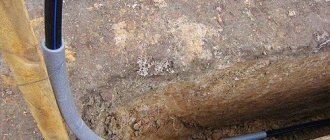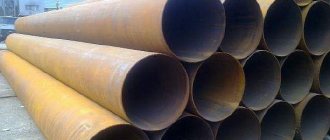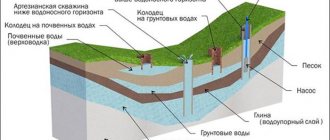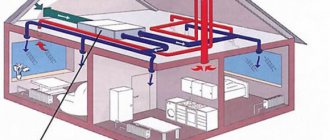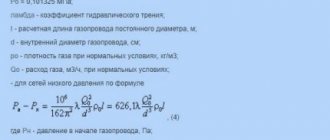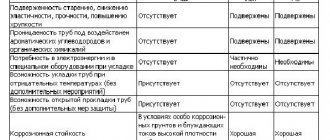Beginning in the second half of the 18th century in England, the industrial revolution in the 19th century swept through many countries in Europe and the world. It was characterized by rapid development of technology and industrial production. Production of products moved from manufactories and workshops to large factories and factories. However, the transition from single and small-scale production to mass production, as well as the division of labor, required the creation of a variety of design and technological documentation, which led to the development of the applied discipline of drawing.
Method 2: Additional Characters Button
In all Microsoft programs, on the Insert tab there is a button for additional symbols. By clicking on it, you can select and insert a diameter symbol into the text.
The same window opens through the top menu bar “Insert - Additional Symbols”.
If you need to insert a symbol frequently, set up a keyboard shortcut or AutoCorrect for it to save time. Buttons for configuring these options are located below the list of all symbols.
Method 3: Birman layout
Ilya Birman created a keyboard layout that helps you insert frequently used characters using the keyboard. To use it, download and install it on your computer (Windows or Mac). After installation, activate the layout in the Control Panel settings; this is described in detail on the download page.
To insert a diameter symbol, press Right Alt + d .
In order not to forget all the keyboard shortcuts, there is a cheat sheet:
If the symbol on the key is drawn at the bottom, you need to additionally press Shift.
Method 4: Keyboard shortcut
Hold down the Alt key and enter the code one by one: 0216. Be sure to enter the numbers on the number pad (on the right side of the keyboard), otherwise nothing will work. Therefore, this method is not suitable for owners of some laptops.
Characteristics of the diameter sign
Constructing drawings is not an easy task, but you can’t do without it in the modern world. After all, in order to make even the most ordinary item (a tiny bolt or nut, a shelf for books, the design of a new dress, etc.), you first need to carry out the appropriate calculations and draw a drawing of the future product. However, often one person draws it up, and another person produces something according to this scheme.
To avoid confusion in understanding the depicted object and its parameters, conventions for length, width, height and other quantities used in design are accepted all over the world. What are they? Let's find out.
Steel
Steel pipe size chart
When installed with steel products, their selection is made according to the outer diameter of the water supply system pipe. According to the requirements of GOST 10704–91, they are divided into groups:
- large diameter - from 508 mm;
- medium – 114-530 mm;
- small – up to 114 mm.
In home plumbing, the most popular products are those with small sizes. Medium - in the city water supply. Large - for main oil and gas pipelines. The most popular products include:
- ½” - 12.7 mm;
- ¾” - 19.0 mm;
- 1” - 25.4 mm;
- 1½” - 38.1 mm.
Specialists who are involved in laying and repairing water pipes on a daily basis know these values by heart, while others look them up in tables.
Quantities
Area, length, width, height and other designations of a similar nature are not only physical, but also mathematical quantities.
Their single letter designation (used by all countries) was established in the mid-twentieth century by the International System of Units (SI) and is still used to this day. It is for this reason that all such parameters are indicated in Latin, and not in Cyrillic letters or Arabic script. In order not to create certain difficulties, when developing design documentation standards in most modern countries, it was decided to use almost the same conventions that are used in physics or geometry.
Read also: The brushes on the screwdriver spark
Any school graduate remembers that depending on whether a two-dimensional or three-dimensional figure (product) is depicted in the drawing, it has a set of basic parameters. If there are two dimensions, these are width and length, if there are three, height is also added.
So, first, let's find out how to correctly indicate length, width, height in the drawings.
1. What is Asbestos
Asbestos (Greek for “indestructible”) is a name that refers to a group of fine-fiber minerals from the silicate class. In nature, these are aggregates with a spatial structure in the form of the finest flexible fibers. It is used in a wide variety of fields, such as construction, the automotive industry and rocket science.
2. What types of asbestos are there?
There are two main types of asbestos - serpentine (chrysotile asbestos, or white asbestos) and amphibole (amphibole asbestos). Serpentines form folded, twisted or bent fibers and generally pose fewer health risks. Amphiboles have straight, needle-shaped fibers - due to the fragility of these structures, they form particles, the inhalation of which is a carcinogenic factor.
3. Chemical composition of asbestos
In terms of their chemical composition, asbestos is aqueous silicates of magnesium, iron, and partly calcium and sodium.
4. Properties of asbestos
Asbestos has high fire resistance, therefore it is used in compounds and compositions where a combination of flexibility and heat resistance is required. The unique properties of asbestos have given rise to many legends about it. In one of them, asbestos is called the hair of a salamander, a mysterious lizard that lives in fire. In the Urals, asbestos has long been called stone tow; napkins and tablecloths that do not burn in fire were woven from it. The words chrysotile and asbestos are of Greek origin and translated into Russian mean thin golden hair and inextinguishable. Chrysotile asbestos is the only mineral that has a fine-fiber structure. Lamp wicks made from it in ancient times served for a very long time.
5. Use of asbestos
Asbestos is included in more than three thousand products in various fields of technology. Filters, tarpaulins, protective suits (for firefighters), paper, cardboard, asbestos-cement building materials, etc. are made from asbestos fibers. The largest deposits of the mineral are located in Canada, South Africa and Russia - in the Urals (Bazhenovskoye and Kiembaevskoye deposits), in the Eastern and Western Sayan Mountains, as well as in the North Caucasus and Tuva (Ak-Dovurakskoye), in the west of Kazakhstan (Dzhetygarinskoye), in China, the USA, Italy, France, Finland, Japan, Australia, and Cyprus.
6. Health effects of asbestos
Asbestos is practically inert and does not dissolve in body fluids. However, some types of asbestos, if ingested into the lungs, can cause various health disorders and diseases.
Since the end of the twentieth century, a campaign has been launched to replace asbestos with safer materials. It is believed, although not clearly proven, that asbestos is a carcinogenic substance (if inhaled). This applies to the greatest extent to the types of asbestos traditionally mined and used in Europe. However, long-fiber chrysotile asbestos produced in Russia has significantly lower toxicity rates (tens of times). In this regard, the displacement of asbestos from domestic production does not always have a rational basis, since “alternative” materials during production also cause a certain increased burden on the ecological state of the environment.
Its consumption in Europe has recently been rapidly declining. They try, if possible, not to use asbestos in residential construction (in the late 1980s, Yugoslav hired workers in Europe received $10 an hour for work removing old plaster materials containing asbestos). On January 1, 1997, the use of asbestos was banned in France. However, there is no evidence of a pro-carcinogenic effect when asbestos is ingested through food.
Source -
Wikipedia
Information on the topic:
Width
As mentioned above, in mathematics the quantity in question is one of the three spatial dimensions of any object, provided that its measurements are made in the transverse direction. So what is width famous for? It is designated by the letter “B”. This is known all over the world. Moreover, according to GOST, it is permissible to use both capital and lowercase Latin letters. The question often arises as to why this particular letter was chosen. After all, the abbreviation is usually made according to the first letter of the Latin, Greek or English name of the quantity. In this case, the width in English will look like “width”.
Probably the point here is that this parameter was initially most widely used in geometry. In this science, when describing figures, length, width, height are often denoted by the letters “a”, “b”, “c”. According to this tradition, when choosing, the letter "B" (or "b") was borrowed from the SI system (although symbols other than geometric ones began to be used for the other two dimensions).
Most believe that this was done so as not to confuse width (designated with the letter "B"/"b") with weight. The fact is that the latter is sometimes referred to as “W” (short for the English name weight), although the use of other letters (“G” and “P”) is also acceptable. According to international standards of the SI system, width is measured in meters or multiples (multiples) of their units. It is worth noting that in geometry it is sometimes also acceptable to use “w” to denote width, but in physics and other exact sciences such a designation is usually not used.
In what situations is there a need for a diameter symbol?
There are many situations in which there is a need to insert the “Ø” sign into the desired electronic file. For example, it may be required when drawing up drawings, detailed design of price lists, design of advertising products, or designation of pipe products or shut-off valves. Pupils, students or employees of all kinds of institutions, enterprises or organizations use this sign every day in the course of their educational or work activities.
The list of examples of using the diameter icon can be endless, but it is clear that in some situations it is quite difficult or uncomfortable without it. That is why further in the text we will look at three ways to insert a diameter symbol into an electronic document.
First way
The most popular way is to use ASCII codes . It can be carried out directly by the Windows OS itself. To implement it, it is important to know the code – “0216”, which is recognized in the ASCII code table as the character “Ø”. The input algorithm will be as follows:
- Select the input language “English”.
- Make sure that the “Num Lock” key is turned on; if it is not lit at the top of the button, then you need to turn it on.
- Then we go to our application. The next step is to point our mouse pointer (arrow) over the work area and click once with the left button. The cursor should blink.
- Now press the “Alt” key (no matter which side, left or right). Then, without pressing it, press 02 16 . Now release all the keys, after which the diameter icon will appear.
The main advantage of this method is that it is universal. It can work in many existing applications. The peculiarity of the method is that the symbol itself is not needed as a source. The disadvantage of this method is that you always need to know the code.
Second way
Word and other applications The interchangeable input method “Ø” is associated with a specific set of software applications such as: Microsoft Office Word, Excel and others. For example, let’s enter the diameter sign in “Word”. In other cases, the input algorithm will be similar. While working, go to the “Insert” tab on the toolbar. It is located at the top of the screen between the “Home” and “Page Layout” tabs. Place the mouse cursor on this tab and click once with the left button. After that, on the right side of the screen we see the “Symbols” panel. There we select the “Symbol” line and in the list that appears, click “Other symbols”. All these actions are carried out with the right mouse button.
Now you can see the insertion window that opens. We find the “Ø” sign we need by scrolling through the found characters. The mouse wheel will help us with this. After a successful search for “Ø”, select it with one click of the left mouse button and click the “Insert” button. After this, close the window. Then the diameter icon will probably appear in Word (in the work area). The negative side of this method is that it will only work in one group of software products. Therefore, it cannot be applied everywhere.
Third way
Also, one of the ways to insert “Ø” is to use the clipboard and use the “Copy” and “Paste” functions. The clipboard is a certain part of the memory of a computer operating system, which is designed for temporary storage of information. First you need to find such a symbol somewhere.
As an example, you can insert the diameter icon into Word in accordance with the above algorithm. Then select it and copy it (if desired, you can use the so-called hot keys “Ctrl”+”C”). Then go to another application and perform the paste action (“Ctrl”+”V”). The negative side of this method is that in any case the original symbol is needed. And this does not always happen.
Each user can choose the most suitable method for inserting the diameter symbol (sign) - “Ø”, taking into account his individual approach and personal skills.
Length
As already mentioned, in mathematics, length, height, width are three spatial dimensions. Moreover, if width is a linear dimension in the transverse direction, then length is in the longitudinal direction. Considering it as a quantity of physics, one can understand that this word means a numerical characteristic of the length of lines.
In English this term is called length. It is because of this that this value is denoted by the capital or lowercase initial letter of the word - “L”. Like width, length is measured in meters or their multiples (multiples).
Height
The presence of this value indicates that we have to deal with a more complex - three-dimensional space. Unlike length and width, height numerically characterizes the size of an object in the vertical direction.
In English it is written as "height". Therefore, according to international standards, it is denoted by the Latin letter “H” / “h”. In addition to height, in drawings sometimes this letter also acts as a designation for depth. Height, width and length - all these parameters are measured in meters and their multiples and submultiples (kilometers, centimeters, millimeters, etc.).
Symbols on diagrams
The concept of diameter for a pipeline includes several characteristics, these are:
- External Dн (international designation ID - Inner Diametr) is measured along the outer circumference.
- Internal (international designation OD - Outer Diametr) is determined by the wall thickness, this is the difference between the outer size and two wall thicknesses
- The conditional bore (Dу), also known as the nominal diameter, corresponds to the internal diameter, rounded to the nearest standard value. The value is regulated by GOST 28338-89.
The wall thickness is standardized. The permeability and strength of the pipe, as well as its weight, depend on it.
Radius and diameter
In addition to the parameters discussed, when drawing up drawings you have to deal with others.
For example, when working with circles, it becomes necessary to determine their radius. This is the name of the segment that connects two points. The first of them is the center. The second is located directly on the circle itself. In Latin this word looks like "radius". Hence the generally accepted abbreviation: lowercase or capital “R”/“r”.
When drawing circles, in addition to the radius, you often have to deal with a phenomenon close to it - diameter. It is also a line segment connecting two points on a circle. In this case, it necessarily passes through the center.
Read also: How to charge pinky batteries
Numerically, the diameter is equal to two radii. In English this word is written like this: “diameter”. Hence the abbreviation - large or small Latin letter “D” / “d”. Often the diameter in the drawings is indicated using a crossed out circle - “Ø”.
Although this is a common abbreviation, it is worth keeping in mind that GOST provides for the use of only the Latin “D” / “d”.
Diameter Symbol, Symbol and Icon: Three Ways to Insert It
Not all symbols are present on a computer keyboard. There is no diameter symbol on it either. The generally accepted designation for diameter is as follows – “Ø”. But there are many ways to insert it in many different applications. The most popular among them is the use of ASCII codes. The second method is associated with the Microsoft office suite and only works there. The third method is to use the clipboard. To execute it, you need the diameter icon itself, which will be inserted into the desired application using the “copy” and “paste” function.
All methods will be discussed in detail and presented in this article.
Thickness
Most of us remember school mathematics lessons. Even then, teachers told us that it is customary to use the Latin letter “s” to denote a quantity such as area. However, according to generally accepted standards, a completely different parameter is written in drawings in this way - thickness.
Why is that? It is known that in the case of height, width, length, the designation by letters could be explained by their writing or tradition. It’s just that thickness in English looks like “thickness”, and in the Latin version it looks like “crassities”. It is also not clear why, unlike other quantities, thickness can only be indicated in lowercase letters. The notation "s" is also used to describe the thickness of pages, walls, ribs, etc.
The importance of choosing the required diameter
Which metal pipes to use for water supply in an apartment or house in order to eliminate unnecessary losses during the transportation of water flow must be determined at the stage of preparation for construction.
How does the internal diameter of steel pipes affect the operation of the pipeline:
- using a small value at high pressure in the network leads to noise in the pipeline, leakage is possible at the joints and installation of fittings;
- an exceeded size will require higher pressure in the system, unnecessary energy consumption;
- the cross-section of the pipeline depends on its length; long sections will require products of a larger cross-section;
- The size is affected by the number of connections, turns, branches, and points of consumption.
Insufficient internal passage of the water supply will lead to disruption of the uniform distribution of water flow. When a tap is open in one place, the pressure at other points will be low or there will be no pressure at all. This causes inconvenience and stops the operation of household appliances - washing machine, dishwasher, boiler.
A reduced cross-section of the pipeline leads to constant increased pressure in the system; it will work under strain, which leads to breakdowns and a decrease in its reliability. Correct preliminary calculations taking into account the laws of hydrodynamics will allow you to design an efficient water supply network and select the required sizes of pipes and shut-off plumbing fittings.
Perimeter and area
Unlike all the quantities listed above, the word “perimeter” does not come from Latin or English, but from Greek. It is derived from “περιμετρέο” (“to measure the circumference”). And today this term has retained its meaning (the total length of the boundaries of the figure). Subsequently, the word entered the English language (“perimeter”) and was fixed in the SI system in the form of an abbreviation with the letter “P”.
Area is a quantity that shows the quantitative characteristics of a geometric figure that has two dimensions (length and width). Unlike everything listed earlier, it is measured in square meters (as well as in submultiples and multiples thereof). As for the letter designation of the area, it differs in different areas. For example, in mathematics this is the Latin letter “S”, familiar to everyone since childhood. Why this is so - no information.
Variations and generalizations
The concept of diameter allows natural generalizations to some other geometric objects.
- The diameter of a conic section is defined as a straight line passing through the midpoints of two parallel chords.
- diameter of a metric space
is understood as the exact upper bound of the distances between pairs of its points. In particular: The diameter of a graph is the maximum of the distances between pairs of its vertices. The distance between vertices is defined as the smallest number of edges that must be traversed to get from one vertex to another. In other words, this is the distance between two vertices of the graph that are as far apart as possible. - The diameter of a geometric figure is the maximum distance between the points of this figure.
- The diameter of a set lying in a metric space with a metric is called the quantity . For example, the diameter of an n
-dimensional hypercube with side
s
is equal to
.
Source of the article: https://dic.academic.ru/dic.nsf/ruwiki/7385
Other common abbreviations
The designations for height, width, length, thickness, radius, and diameter are the most commonly used when drawing up drawings. However, there are other quantities that are also often present in them. For example, lowercase "t". In physics, this means “temperature,” however, according to GOST of the Unified System of Design Documentation, this letter is the pitch (of helical springs, rivet joints, etc.). However, it is not used when it comes to gears and threads.
The capital and lowercase letter “A”/“a” (according to the same standards) in the drawings is used to denote not the area, but the center-to-center and center-to-center distance. In addition to different sizes, in drawings it is often necessary to indicate angles of different sizes. For this purpose, it is customary to use lowercase letters of the Greek alphabet. The most commonly used are “α”, “β”, “γ” and “δ”. However, it is acceptable to use others.
Indication of the nominal diameter depending on the type of pipe
When indicating the nominal diameter for pipeline fittings, everything is extremely simple. The rounded internal diameter is indicated, for example, like this: DN20, but sometimes an outdated designation can be found: DN20, or Dy20, according to the previously valid CMEA 254-76.
But with the indication for different types of metal and plastic pipes, not everything is so simple, and confusion often occurs due to incorrect indication or uncertainty as to what diameter is indicated, external or internal (nominal diameter).
And the question arises, how is the pipe diameter correctly indicated? The following are examples of correct designations for some types of pipelines.
Designation of water and gas pipe (VGP pipe)
Water and gas pipes (WGP) include metal welded products made of steel in accordance with GOST 1050 and GOST 380, as well as other approved regulations. Applicable:
- In building heating systems;
- Various types of water pipelines;
- In the designs of gas pipeline systems and gas pipelines;
Example notation
Steel pipe manufactured in accordance with GOST 3262-75, with a nominal bore of 32 millimeters and a wall thickness of 3.2 millimeters.
The same thing only with the clutch.
Steel VGP with thread, zinc coating, cut to length. And so on.
Designation of electric-welded straight-seam pipes
Straight-seam electric welded steels are made from low-alloy or carbon steels. Used for the manufacture of pipelines for various applications.
Example notation
Steel pipe, produced in accordance with GOST 10704-91, with an outer diameter of 70.0 millimeters, a wall thickness of 4.0 millimeters, measured length (5000 mm), class II (manufacturing accuracy along the length), made of steel “StZsp”, produced in accordance with group “B” of GOST 10705- 80.
Specifying the diameter of seamless steel pipes
Seamless steel pipes are made from alloy or carbon steels. The absence of seams increases the resistance of the pipeline to various physical influences, such as operating temperature and nominal pressure.
Example notation
Steel pipe produced in accordance with GOST 32528-2013, with an outer diameter of 60.0 millimeters, a wall thickness of 4.0 millimeters, measured length (6000 mm), increased manufacturing accuracy, grade 40X steel, produced according to group “B”.
Unmeasured length, produced in accordance with GOST 32528-2013, with an outer diameter of 95.0 millimeters and an internal diameter of 76.0 millimeters, steel grade 10, produced according to group “B”.
Indication of plastic pipe diameters
Plastic pipes and various fittings are made from the following types of thermoplastics:
They are used for the manufacture of heating pipes, hot and cold water pipelines in accordance with GOST 32415-2013.
Example of designation of plastic pipes and fittings
Manufactured from uPVC, with a nominal outside diameter of 25.0 millimeters, a nominal wall thickness of 2.3 millimeters, and a pressure rating of PN25.
Symbol for plastic fittings:
Coupling made of PVC-U for connecting pipelines with DN 63.0 mm, complies with SDR 13.6, nominal design pressure PN16.
What standard defines the letter designation of length, width, height, area and other quantities?
As mentioned above, so that there is no misunderstanding when reading the drawing, representatives of different nations have adopted common standards for letter designation. In other words, if you are in doubt about the interpretation of a particular abbreviation, look at GOSTs. This way you will learn how to correctly indicate height, width, length, diameter, radius, and so on.
For the Russian Federation, such a regulatory document is GOST 2.321-84. It was introduced back in March 1984 (during the times of the USSR), to replace the outdated GOST 3452-59.
Type Tubes
The word Tubes refers to pipes that are marked by outer diameter. The internal one will depend on the wall thickness. Therefore, this standard also contains the concept gauge, which can be translated as gauge. It just indicates the wall thickness.
The same diameters of steel pipes do not mean the same weight
The marking is marked with ASTM. The numbers following the abbreviation describe the outer diameter. In this group, we may be interested in copper pipes.

